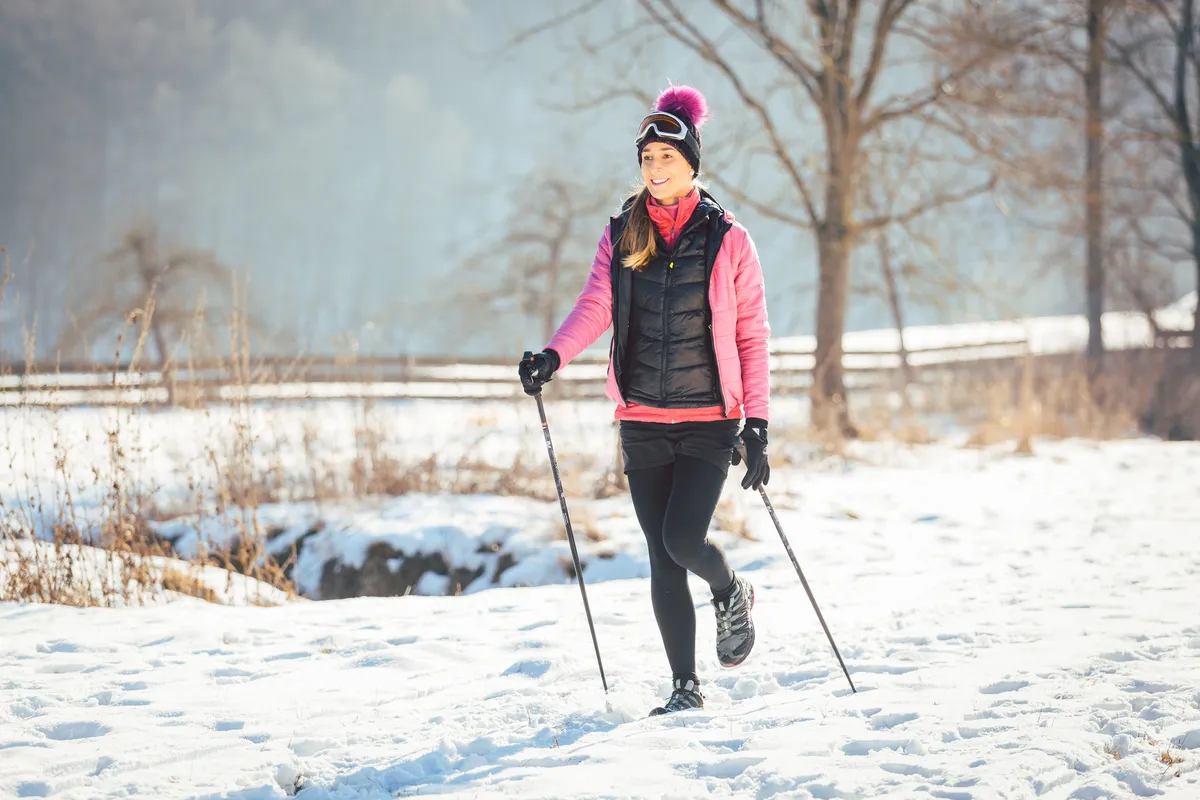Nordic walking was originally a summer training regime for cross-country skiers. It has evolved over the years and is now an activity that can be enjoyed all through the year in any part of the world, whether you're a skier or not. No Lycra required.
Level 4 advanced fitness instructor Debbie Jackman explains why Nordic walking is a great workout and how it tones the body.
What is Nordic walking?
Nordic walking is a specific pole-walking technique, which utilises the upper body to propel the walker along. It is often referred to as 'full body walking', as it uses more muscles than basic walking.
Nordic walking is different to trekking with poles, which is more about maintaining balance and taking weight off joints. Nordic walking is good for balance, too, but it also pushes the walker forward, increasing stride length and engaging the lower leg muscles.
Nordic walking can be done by anyone, anywhere.
Nordic walking technique
Here's how to Nordic walk.
- Adjust your poles so that when your arms are bent at the elbows 90 degrees, you can comfortably hold the handles. If the poles are vertical then they will not push you forward. If the poles are angled behind, then they will. We naturally swing our arms when we walk, and this movement is what we use when Nordic walking.
- To get started, swing or punch your arms forward as you walk, pushing into the poles (which are always planted at an angle). If the poles miss the ground, you usually have too tight a hold, so relax your grip.
- These are the basics. To learn more – including how to tackle hills – contact a local instructor for more in-depth advice. This will help you to develop your technique further.
- One way to feel the power of the poles is mid-walk, when pushing into your poles, lift your poles up and feel the power disappear. You often don’t realise what the poles do until you take them away.
Do you have to use special Nordic walking poles?
Traditional Nordic walking poles are unique in so far as there is a glove-style strap attached to the pole so that your grip is relaxed, and you don’t hold tension in your forearm. It also enables you to take your arm swing further back as you are attached even without gripping.
There are also strapless poles, which have a power ledge for those who may find the gloves fiddly or have pain in their hands when wearing the gloves.
The poles have metal tips plus angled rubber paws that fit on top for hard surfaces.
That said, I believe you can use the Nordic walking technique with any walking poles. Simply angle your poles backwards. For me Nordic walking is more about the technique than the equipment.
How energetic is it?

Anyone can harness the power of poles. Those with Parkinson’s or balance issues enjoy Nordic walking as it gives them confidence and assists with stabilisation. All the way to those who complete in ultra races, who use the poles to take the workload off their legs and to power up hills. So, as you can see, it can be as energetic or as easy as you like.
Why is Nordic walking good for you?
Nordic walking can raise the heart rate and challenges the cardio system, especially when you fully engage with the poles. It also feels easier as the poles make you lighter on your feet.
When you press into poles you strengthen the arms and core. It is a pulling movement, which in our modern day lives we don’t do often, so assists with posture and shoulder strength. It spreads the workload throughout your body so if you have issues with your knees or back then you take some of your weight into your arms and off these areas.
What muscles does Nordic walking tone?
With Nordic walking every step you take becomes a full-body exercise. Nordic walking uses 90% of the major muscles, plus shares the load between upper and lower body. It tones the shoulders and arms, engages the core and tones the stomach and upper back, plus due to the push off through the feet, strengthens the ankle joint and lower leg muscles
The more you press into the poles the more you spread the workload throughout your body.
Is Nordic walking good for your knees?
Yes! When you press into the poles you take the weight off your knees. Also, by being aware of how you roll through your feet you can assist knee position and reduce pain.
Need new walking boots? Check out our choice of the best walking boots tested and reviewed or do you prefer walking shoes?
If you do have any medical issues, concerns or worries always seek medical advice from a doctor before starting a new activity or fitness regime.
More walking tips and kit advice
- Walking groups: how to find and join a walking group
- Britain's most epic walking challenges
- How to clean walking boots
- How to dry walking boots
- Best walking trousers to buy
- The best walking socks for all hiking conditions
Who is Debbie Jackman
Debbie Jackman is a level 4 advanced fitness instructor in Cumbria who has 17 years of experience.
She regularly teaches Nordic walking with both strapless plus traditional poles.
More information can be found at www.get-active.co.uk